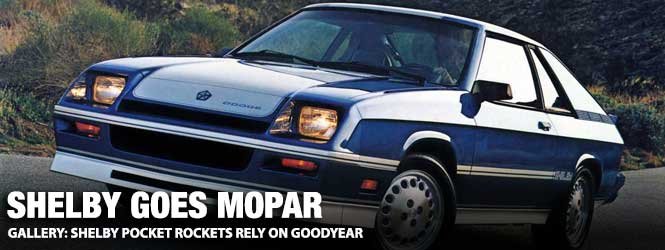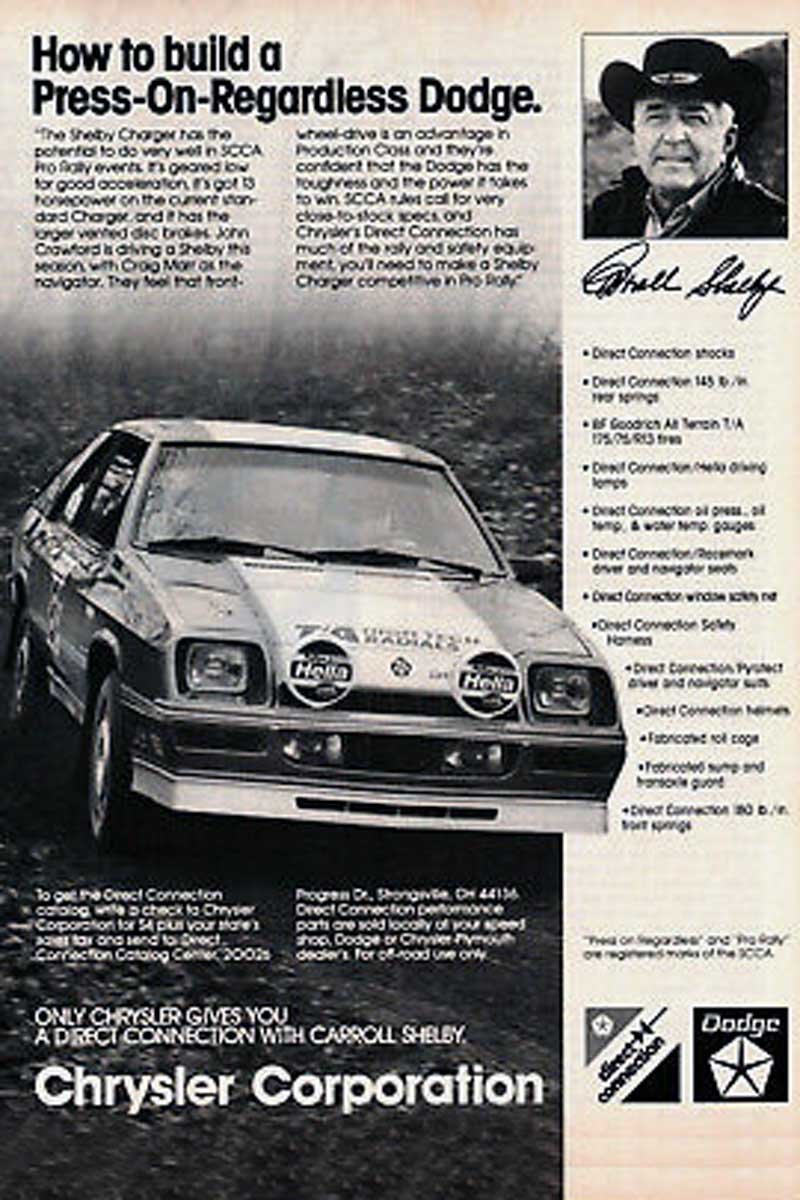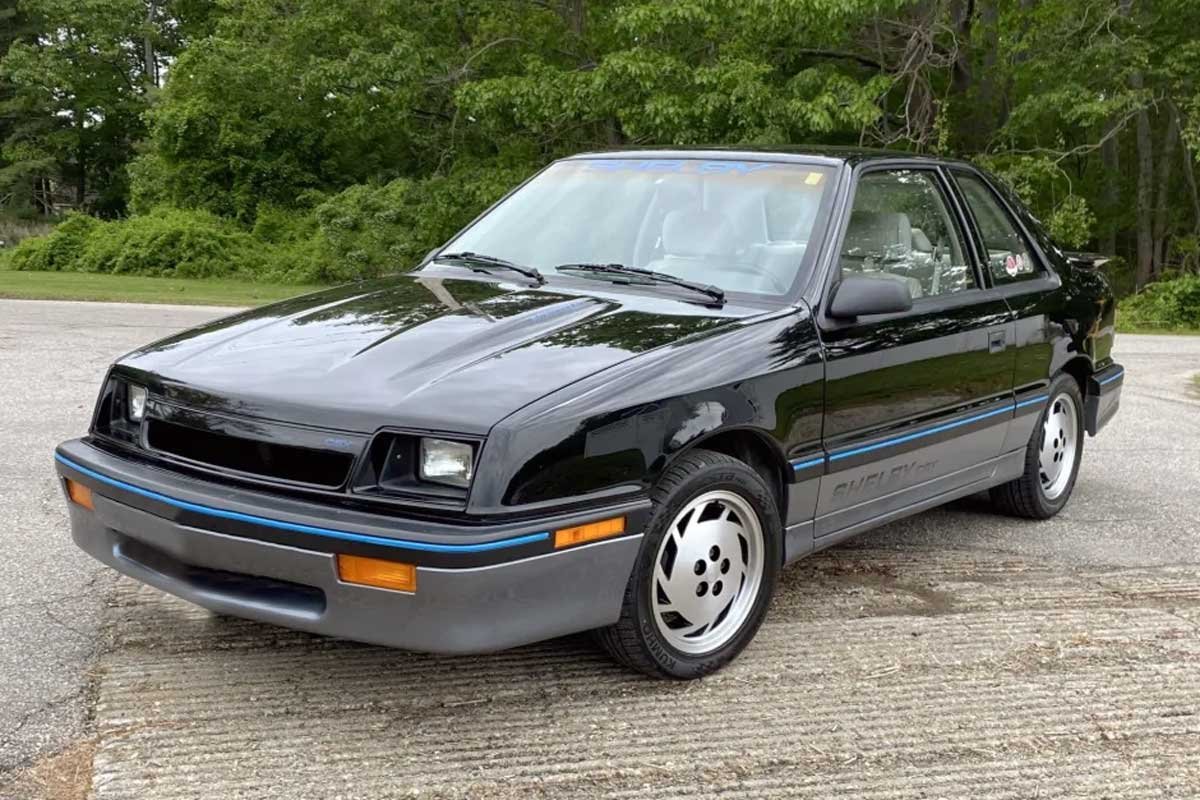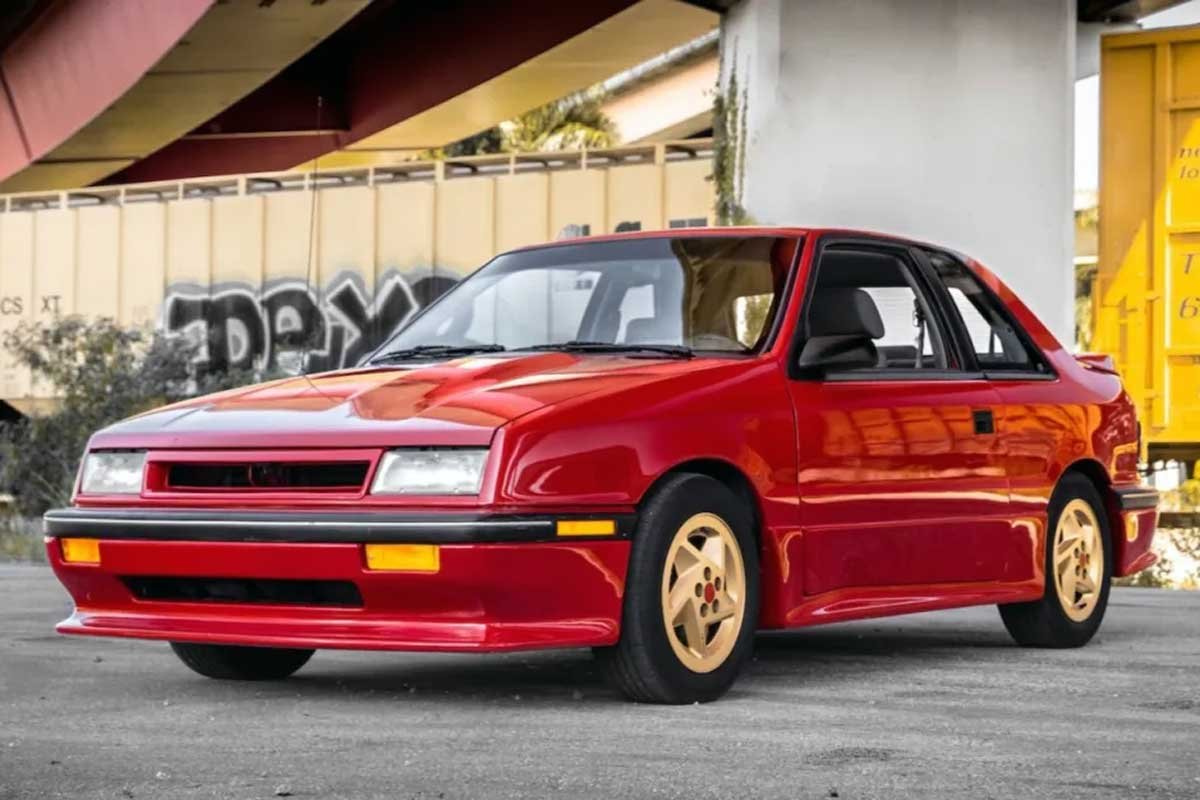
Carroll Shelby is best known for his association with Ford and the development of the Shelby Cobra and Shelby Mustangs. However, there was a brief period in the 1980s when Shelby worked with Chrysler’s performance division, Direct Connection, to create a series of high-performance Dodge vehicles.
Above Left: Goodyear celebrated the Shelby and Chrysler union with an advertisement discussing the use of Goodyear tires. Shelby always had great success with Goodyear since his involvement with them on his original Cobras. Above Right: Chrysler Corporation’s Direct Connection also advertised its partnership with Shelby.
Shelby was lured to Chrysler by former Ford executive and current Chrysler Chairman Lee Iacocca, who sought a touch of performance in the Dodge line. Nearly every Chrysler vehicle was front-wheel drive (FWD), a push of Iacocca, who in 1979 had gone to the United States government to guarantee loans to keep the company viable. In the 1980s, Shelby stamped his name on the side of several models during his time with the Chrysler Corporation.
The first of several FWD Mopars was the Dodge Shelby Charger (1983-1987). The Shelby Charger was a performance-oriented version of the regular Dodge Charger. Shelby’s modifications included a turbocharged engine, stiffer suspension, and various exterior and interior enhancements. These cars were aimed at the budget-conscious performance enthusiast.

Above: With an emphasis on cornering, Shelby modified the suspension and styling. A set of shorter springs, unique wheels, and Goodyear tires complimented better brakes and a 14:1 power steering rack. Speed was not a focus of the early Chargers, but the engine compression was raised slightly, resulting in 107 hp, passed through a revised manual transaxle. (Photographer unknown)
With the success of the Shelby Charger, Shelby expanded the line to include a Dodge Omni GLH (Goes Like Hell) (1985-1987). The Dodge Omni GLH was a compact hatchback with significant performance upgrades by Shelby. It featured a turbocharged 2.2-liter engine and sportier suspension, making it a quick and agile little car for its time.

Above: Dodge and Shelby began offering the Shelby-tuned Omni GLH with a high-output 2.2-liter I4 engine making 110hp (82kW). Turbocharged GLH-T models arrived in 1985. (Photographer unknown)
In 1986, Shelby introduced the Shelby GLHS (Goes Like Hell S’more) (1986-1987). The Turbo I engine experienced wide-ranging reformation, adopting several components from soon to be announced Turbo II engine, introduced in 1987. The engine received a larger turbocharger and throttle body, a matching intercooler, tuned intake and exhaust manifolds, new radiator and engine fan designs, and a new wiring harness.
Shelby improved the excellent suspension of the GLH with high spring rate coil springs and Koni front struts and rear shocks. Lastly, even larger Goodyear tires were mounted on Shelby-designed wheels.
Above Left: The Shelby GLHS was based on the Dodge Omni. The GLHS featured a turbocharged and intercooled 2.2-liter inline-four engine, producing around 175 horsepower and 175 lb-ft of torque, which was impressive for any FWD. Above Right: The 1987 Shelby Charger GLHS was based on the Dodge Charger and was part of a limited production run, with only 1,000 units built. The Charger featured a 2.2-liter turbocharged and intercooled inline-four engine. Like its Omni sibling, the Shelby Charger GLHS is now considered a collectible classic, and enthusiasts appreciate it for its combination of compact size, turbocharged power, and Shelby’s performance touches. (Photographers unknown)
The performance increased again with the latest FWD Dodge offering, the Shelby CSX (Carroll Shelby Experimental) (1987-1989). The Dodge Shelby CSX was based on the Dodge Shadow. It was more refined than the earlier Shelby Charger and Omni GLH. It featured a 2.2-liter Turbo II inline four-cylinder engine pumping out 175 horsepower (hp) and 175 lb-ft of torque. The CSX received various suspension and handling improvements.
In 1989, Shelby turned up the wick with updates to the CSX, dubbed the Shelby CSX-VNT. The CSX-VNT became the last Shelby-badged Dodge FWD ever produced. The three-door hatchback had a Turbo IV engine and a Getrag A555 5-speed manual. The engine had the same horsepower as the Turbo II at 175 hp, but the torque was up to 205 lb-ft. The Shelby was the first production vehicle to utilize a Garrett variable-nozzle turbo (VNT), which decreased turbo lag and improved performance.
Above: The last of the Shelby FWD vehicles was the CSX model. The models were the Shelby CSX (left), the CSX-T (middle), and the CSX-VNT (right). (Photographers unknown)
The last Dodge to receive the Shelby touches was the Dodge Viper (1991-2017). While the Viper was not a Shelby-branded vehicle, it’s worth mentioning Shelby’s involvement in its development. He helped in the early stages of the Viper’s development, providing input and advice. The Viper was a high-performance sports car with a massive V10 engine and became an iconic American sports car.
Founded in 1989 by Frank Seiberling in Akron, Ohio, the Goodyear Tire & Rubber Company is a well-known American tire manufacturer. The company is one of the world’s largest tire producers and has an extensive history of constructing tires for various applications, including automobiles, trucks, aircraft, industrial equipment, and more.

Above: Goodyear moved the tire technology forward substantially over the last 125 years. As the auto industry has expanded, Goodyear has met every requirement of the automotive manufacturers. (Photographer unknown)
Goodyear is known for its innovation in the tire industry. It developed multiple technologies and tire designs, such as the invention of vulcanized rubber, the development of all-season tires, and advancements in tire tread and composition. In the 1960s and early 1970s, Goodyear Polyglas tires were top-rated.
The Goodyear Polyglas tires were known for their distinctive and unique design, which featured a raised white lettering on the tire’s sidewall. They were a common choice for American muscle cars and other high-performance vehicles of that era. The tires were favored due to the tires’ performance capabilities and their contribution to the overall aesthetic of the vehicles. The raised white letters provided a bold and eye-catching appearance, making them a sought-after choice for many car enthusiasts.

Above: The Goodyear Polyglas tire was extremely popular during the muscle car era. The tire was known for its performance and impressive appearance with the raised white letters on the tires.
While Goodyear did not invent the radial tire, it played a significant role in popularizing and developing it. It was Goodyear, along with other tire manufacturers, that adopted and further refined the radial tire technology. Goodyear’s contribution to the development of radial tires and its subsequent production helped make radials a standard due to superior performance, fuel efficiency, and longevity. Radial tires revolutionized the tire industry and became widely adopted for passenger cars, trucks, and other vehicles.
In addition to tire manufacturing, Goodyear has been involved in various other industries, including aerospace, automotive products, and different synthetic rubber and chemical products. The company has a global presence and distributes its products to markets worldwide. The company’s blimps, often seen at major sporting events, have also symbolized its brand.

Above: The original Goodyear blimp was introduced in 1917. Goodyear made blimps for advertising purposes and made them for the Navy. The modern Goodyear airships are the most popular and recognized “blimps” in the world. (Photographer unknown)
As depicted in the Goodyear advertisement, Shelby relied on Goodyear tires from his original Cobras to the Direct Connection Mopars. Goodyear radial tires for a Shelby Mopar can be sourced from multiple local outlets, and for those looking for Goodyear Polyglas tires, check out Classic Industries.















 Mopar Connection Magazine – The ONLY Daily Mopar Magazine © 2022. All Rights Reserved. Mopar Connection Magazine is the ONLY daily Mopar Magazine bringing you the latest Mopar news, technology, breaking news, and Mopar related events and articles. Find out the latest information about Mopar, Mopar products and services, stay up to date on Mopar enthusiast news, dealership information and the latest Mopar social media buzz! Sign up for the Mopar Connection Magazine newsletter for the latest information about new products, services and industry chatter. Mopar Connection Magazine is the best and only source you need to be a Mopar industry insider!
Mopar Connection Magazine – The ONLY Daily Mopar Magazine © 2022. All Rights Reserved. Mopar Connection Magazine is the ONLY daily Mopar Magazine bringing you the latest Mopar news, technology, breaking news, and Mopar related events and articles. Find out the latest information about Mopar, Mopar products and services, stay up to date on Mopar enthusiast news, dealership information and the latest Mopar social media buzz! Sign up for the Mopar Connection Magazine newsletter for the latest information about new products, services and industry chatter. Mopar Connection Magazine is the best and only source you need to be a Mopar industry insider! by
by